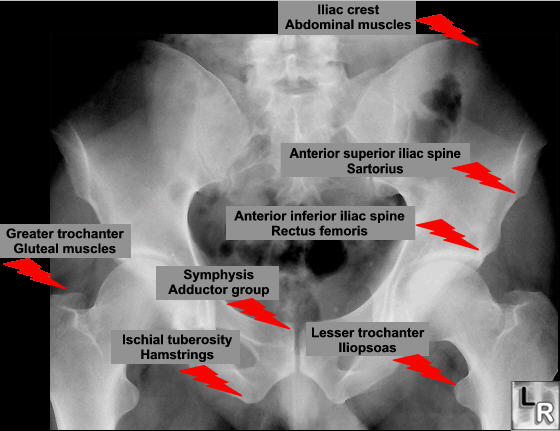|
|
Pelvic Avulsion Fractures
|
Avulsion Anterior Superior
Iliac Spine (ASIS) |
Avulsion Anterior Inferior
Iliac Spine (AIIS) |
|
|
|
Abdominal muscles
Uncommon
Log-distance runners |
Sartorius
Sprinters, hurdlers
Pain below iliac crest
|
Rectus femoris muscle
Less common than ASIS fractures
Kicking in soccer or football
|
Avulsion Ischial Tuberosity
|
Avulsion Greater Trochanter |
Avulsion Lesser Trochanter |
|
|
|
Hamstring
Most common avulsion
Sprinters, cheerleaders, dancers
Pain in buttock
|
Middle and least gluteal, internal obturator, gemellus, and piriform muscles
Sudden directional changes |
Iliopsoas
Rare
Very painful
Runners
|
General Considerations
- Avulsion fractures result when the fracture fragment is pulled from its parent bone by forceful contraction of a tendon or ligament
- Avulsion fractures are most common in younger individuals engaging in athletic endeavors
- In the pelvis, the newly formed secondary centers of ossification, the apophyses, are the most likely portions of the bone to avulse
- Since the apophyses tend to form at the time of puberty, most of these pelvic avulsions occur at the time of puberty
- In general, they are uncommon injuries, seen almost exclusively in adolescent athletes with a 2:1 male to female preponderance
- They occur most often in track events like hurdling and sprinting, or games like soccer or tennis
- Most common to avulse is the ischial tuberosity followed by anterior inferior iliac spine (AIIS) and the anterior superior iliac spine (ASIS) about equally
- Prompt diagnosis will prevent development of chronic pain
Clinical findings
- Acutely, the athlete experiences sudden, shooting pain referred to the involved tuberosity
- They may lose muscular function
- Swelling and local tenderness may occur
- The clinical findings of the fracture are similar to those of soft tissue injuries to the muscles, tendons and ligaments and so may be initially missed
- Most common site of a missed fracture is the ischial tuberosity
Imaging findings
- Since the apophyses occur in anatomically predictable locations, the findings are those of an avulsed bony fragment usually immediately adjacent to the parent bone
- Characteristic of these lesions is fracture healing with exuberant bony callus formation
- Can be confused with a bone tumor but must not be as an osteosarcoma and a healing fracture may appear similar pathologically
- Conventional radiography is the study of first choice
- If negative, magnetic resonance imaging may be helpful in demonstrating soft tissue injury, such as a tear of the tendon of the hamstring muscles

Avulsion Fractures Around the Pelvis and the Attachments of Muscles
Imaging Features of Avulsion Injuries.
MA Stevens, GY El-Khoury, MH Kathol, EA Brandser and S Chow. May 1999, Radiographics, 19, 655-672.
|
|
|